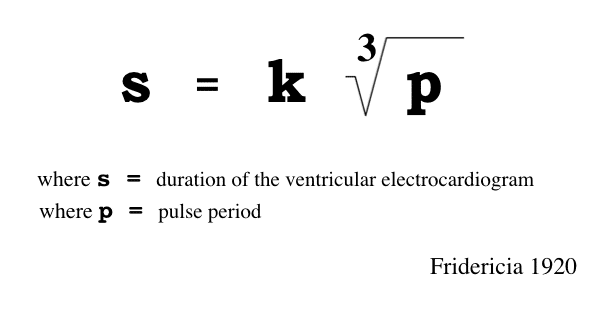Fridericia Formula
Description
A formula for calculating the QT interval on an electrocardiogram (ECG) according to heart rate. Using this formula, Fridericia postulated that QT values >0.43 seconds were considered prolonged
History of the Fridericia Formula
1891 – Augustus Desiré Waller provided a series of values for the duration of mechanical systole with different heart rates. He demonstrated that the period of mechanical contraction (systole) was shortened at faster heart rates
1920 – The Danish physician Louis Sigurd Fridericia (1881 – 1947) hypothesised a relationship between the duration of the ventricular electrocardiogram (s) and the duration of the pulse period (p). He studied 50 healthy individuals (age 3-81 years; 28 males and 32 females) at rest to determine the accuracy and the error rate in the measurement of both the pulse period (p) and the duration of the ventricular electrocardiogram (s).
He found that QT could be predicted accurately from the following formula: s = K (p0.3558) which he then simplified (p0.3558) to ³√p without any significant error; then calculated k (=8.22) for normal healthy individuals.

He concluded that in a normal, resting subject, the duration of electrical systole on an ECG is proportional to the cube root of the duration of the pulse period.

By applying this equation to his data set, Fridericia defined an average (Gauss) error of 0.015 seconds for a single duration. Variations of the observed duration of electrical systole >3 times the average error were considered to be pathological. Therefore the upper value for a ‘normal QT interval’ at a heart rate of 60 bpm was defined as 0.427 seconds (0.382 sec+0.045 s), and so QT values>0.43 seconds were deemed prolonged.
Associated Persons
- Augustus Desiré Waller (1856-1922)
- Henry Cuthbert Bazett (1885-1950)
- Louis Sigurd Fridericia (1881-1947)
Controversies
Charbit B et al in a study of 108 patients found that automatic QT correction using Bazett formula had a sensitivity for detection of QT prolongation of 54% while automatic QT correction using Fridericia formula had 100% sensitivity
At heart rates outside of the 60 – 100 bpm range, the Fridericia or Framingham corrections are more accurate and should be used instead [Framingham heart study, 1992]
References
Original articles
- Waller AD. Circulation. In: An introduction to physiology. 1891: 52
- Fridericia LS. Die Systolendauer im Elektrokardiogramm bei normalen Menschen und bei Herzkranken I: Beziehung zwischen der Pulsfrequenz und der Dauer des Ventrikelelektrokardiogramms bei normalen Menschen in der Ruhe [The Duration of Systole in an Electrocardiogram in Normal Humans and in Patients with Heart Disease. 1. Relationship of the pulse frequency and the duration of the ventricular electrocardiogram in normal humans at rest]. Acta Medica Scandinavica 1920; 53: 469–486
Review articles
- Moss AJ. Introductory note to a translated classic article of L. S. Fridericia. Ann Noninvasive Electrocardiol. 2003; 8(4): 341-342.
- Luo S, Michler K, Johnston P, Macfarlane PW. A comparison of commonly used QT correction formulae: the effect of heart rate on the QTc of normal ECGs. J Electrocardiol. 2004;37 Suppl:81-90.
- Charbit B, Samain E, Merckx P, Funck-Brentano C. QT interval measurement: evaluation of automatic QTc measurement and new simple method to calculate and interpret corrected QT interval. Anesthesiology. 2006; 104(2): 255-60.
- Indik JH, Pearson EC, Fried K, Woosley RL. Bazett and Fridericia QT correction formulas interfere with measurement of drug-induced changes in QT interval. Heart Rhythm. 2006; 3(9): 1003-7
- Cadogan M. History of the Electrocardiogram. LITFL 2020
[cite]
eponymictionary
the names behind the name
